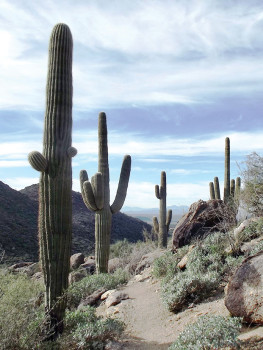Friday is the usual day RR hikers head for the mountains! One hike of particular interest and beauty took place January 23 at the Tortolita Mountains.
Wild Burro, Cochie and Ruelas Canyons cut through the southwest end of the Tortolita Mountains, an unassuming but rugged range just a half-hour drive north of Tucson. A trailhead at Dove Mountain, in the Town of Marana, leads northeast into Wild Burro Canyon where it connects to trails that trace the crest above Cochie Canyon to the northwest or delve into neighboring terrain to the north and east.
The Cardio Hiking Group started at the Wild Burro trail proceeding to the Upper Javelina trail, the Wild Mustang trail and onward to Cochie Canyon trail. The Recreation Hiking Group hiked around the Ritz Carlton using parts of the Wild Burro, Lower Javelina and Upper Javelina trails.
The Tortolita Mountains fall within the Arizona Upland subdivision of the Sonoran Desert, the highest and coldest part of the Sonoran Desert known primarily for its characteristic saguaro cacti. In Wild Burro Canyon the Crested Saguaro Society has identified eight “crested” saguaros, those with unusual and awe-inspiring splayed growth forms atop the main trunk.
The Tortolitas support 600 species of plants, including various species of cholla, prickly pear, hedgehog and barrel cacti; yucca, sotol and agave; creosote bush and ocotillo; palo verde, ironwood and mesquite trees; as well as devil’s claw, bursage and jojoba.
Thousands of species of invertebrates, two species of amphibians, several dozen species of reptiles, about two hundred species of resident and migratory birds, and several dozen species of mammals, including seldom-seen but numerous bats, live in the Tortolita Mountains.
Raptors—carnivorous birds like the Harris hawk, peregrine falcon, prairie falcon, great-horned owl and others often perch in the high branches of trees or atop a tall saguaro. Roadrunners do run the desert ground looking for baby snakes, lizards and other delicacies. Gambel’s quail, cardinals, cactus wrens, Gila woodpeckers, gilded flickers, verdins, gnatcatchers and myriad feathered creatures forage for seeds or insects while hummingbirds prefer to drink nectar from flowers. Jackrabbits, desert cottontails, kangaroo rats, ground squirrels and desert mice abound in the Tortolitas, as do coyote, which prey on them. Larger animals like mule deer, kit fox, bobcat and javelina make an effort to stay out of sight, but tracks and droppings are sometimes seen on the trails. In recent decades bighorn sheep ranged across the Tortolitas, but they are no longer present here. Mountain lions may still travel the Tortolitas, passing back and forth from the Catalinas.
As in past times, both hiking groups met for lunch at Cayton’s Burger Bistro, the signature restaurant at the golf club at Dove Mountain. This restaurant is open to the public and offers a casually elegant setting for a delicious meal on the patio overlooking Dove Mountain golf course.


